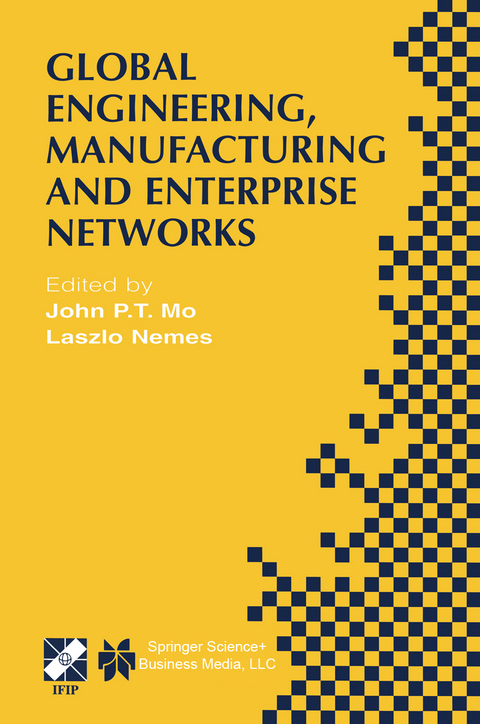
Global Engineering, Manufacturing and Enterprise Networks
Springer-Verlag New York Inc.
978-1-4757-1012-0 (ISBN)
One Keynote.- Accessing Corporate Memory — Some Knowledge Structure Concepts.- Two Virtual Enterprises.- Virtual Enterprise Architecture and its Supporting Methods/Tools for Managing Supply Chain System Life Cycle.- Flexible Infrastructure for Virtual Enterprises.- Assessing Ability to Execute in Virtual Enterprises.- Project-specific Process Configuration in Virtual Enterprises.- Functional Requirements for Inter-enterprise Intranet Services.- The Architecture of an Internet-based Virtual Industrial Community.- From Single Enterprises to Complementary Networks.- Three Modelling and Analysis of Virtual Enterprises.- Use of GERAM as Basis for a Virtual Enterprise Framework Model.- The Component-oriented Approach towards Complex Product Development.- Supporting Partner Selection for Virtual Enterprises.- Specifying Interactions in Integrated Manufacturing Systems.- Modelling Semiosis of Design.- Modelling for Designing, Managing and Improving Virtual Enterprises in One-of-a-kind Business.- An Adaptive Process Management System (APMS).- Modelling Requirements for Self-integrating Manufacturing Systems.- Four Supply Chain Management.- Ergonomic Concerns in Enterprise Resource Planning (ERP) Systems and Its Implementations.- Low-cost System for Supply Chain Management.- A Booking Type Production System as a Collaboration Method for Virtual Enterprises.- Collaborative Design Procedure for Supply Chain Process Integration Using UML.- Agent-based Architecture for Flexible Lean Cell Design, Analysis and Evaluation.- Supply Chain Business System Reference Model: A Business Process Description Using IDEF0.- Five e-Commerce and e-Service.- B2B E-Commerce Infrastructure Using Agents and Standards — A Potential Impact Analysis and Architecture.- A Web-based Bidding Workbench forGlobal Manufacturing.- Web-based maintenance manual with three-dimensional simulation model.- e-Service for Complex Technical Products — a New Approach for Supporting Life-cycle Services.- Automated Management of Quality Control System for Network Enterprise.- Neo-kaizen Applications on the Generic Operations Support and Renewal.- Six Product Development and Life Cycle Management.- Towards Information and Knowledge in Product Realization Infrastructures.- Requirements on Product Information Management in the Sales and Service Life-cycle Phases of a Plant.- A VR-based CAD System.- Dependencies Between Design Product Models and Simulation Models.- A Manufacturing Information Infrastructure to Link Team Based Design to Global Manufacture.- Non-destructive Tracing of a Product Life Cycle Through Geometry Extraction from Radiographs.- Planning for Manufacturing — Managing Connective Designs and Asymmetric Designer Knowledge in Product Consortia.- Product Modelling and Rationale Capture in Design Process.- Agent Design for LCC Information Gathering.- Information Technology and Telecommunication Infrastructure: Network Applications for Hong Kong Business and Service.- Seven Knowledge Management.- Background and Foreground Knowledge in knowledge management.- Standardised Model Data Exchange for Dispersed Systems Engineering Design Teams.- Knowledge Creation at FORTUM Engineering.- Formal Ontology for Participative Simulation.- Managing Technical Documentation for Large Defence Projects: Engineering Corporate Knowledge.- AGORA: An Integrated Knowledge Management Environment.- Eight Information Technologies for Manufacturing.- A Multi-agent Based Information Infrastructure for Manufacturing.- A Cost Estimation Tool Integrated into FIPER.- Collaboration and ApplicationIntegration: Distributed Design with Virtual CAD.- World Wide Web Adapted Geometric Model in the Context of Functional Design.- Moving XML to a Manufacturing Enterprise.- Manufacturing Enterprise Integration Using Simulation Software to Coordinate Budget Planning.- Nine Computer Integrated Manufacturing.- An Expert System for Plasma Cutting Process Quality Prediction and Optimal Parameter Suggestion.- A Computation and Control Architecture of Virtual Manufacturing Shop.- Managing the Flow of Information on the Factory Floor.- Holonic Architecture for Shop-floor Control.- Software Technology for Design System Integration.- Agility Through Design — The Holonic Multi-cell Control System (HoMuCS) Architecture.- Implementation of a Layer Structured Control System on the ‘Glue Logic’.
| Erscheint lt. Verlag | 26.7.2012 |
|---|---|
| Reihe/Serie | IFIP International Federation for Information Processing ; 63 |
| Zusatzinfo | XVI, 496 p. |
| Verlagsort | New York, NY |
| Sprache | englisch |
| Maße | 155 x 235 mm |
| Themenwelt | Mathematik / Informatik ► Informatik ► Datenbanken |
| Informatik ► Office Programme ► Outlook | |
| Mathematik / Informatik ► Informatik ► Theorie / Studium | |
| Technik ► Maschinenbau | |
| Wirtschaft ► Betriebswirtschaft / Management ► Logistik / Produktion | |
| ISBN-10 | 1-4757-1012-7 / 1475710127 |
| ISBN-13 | 978-1-4757-1012-0 / 9781475710120 |
| Zustand | Neuware |
| Haben Sie eine Frage zum Produkt? |
aus dem Bereich


